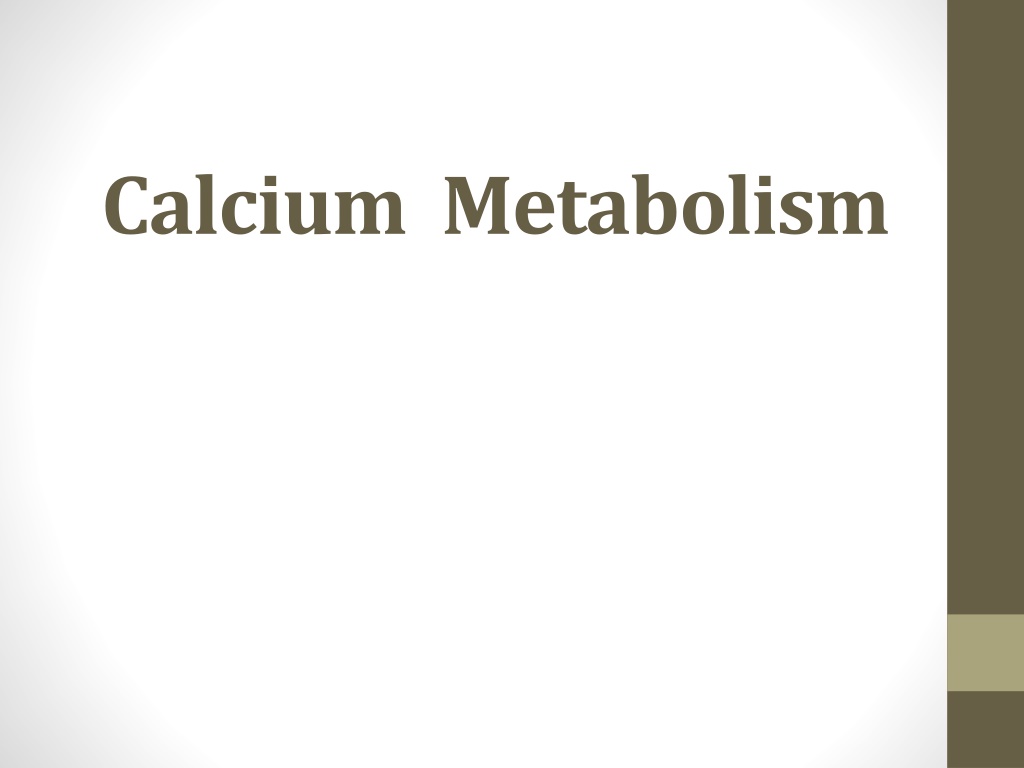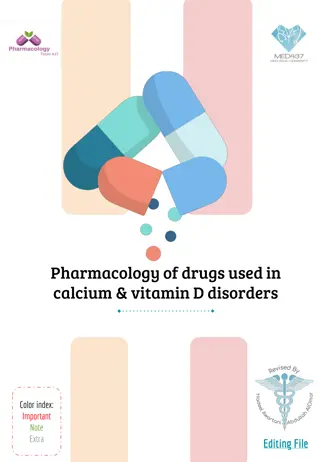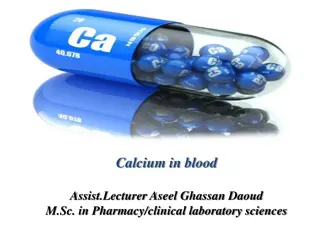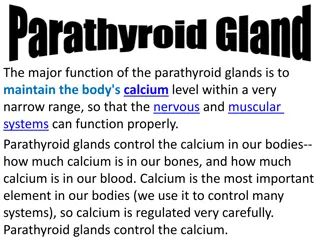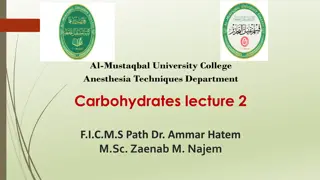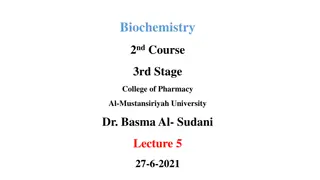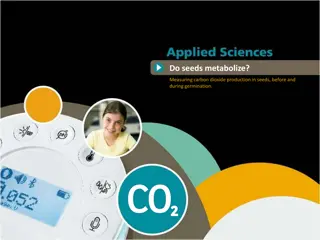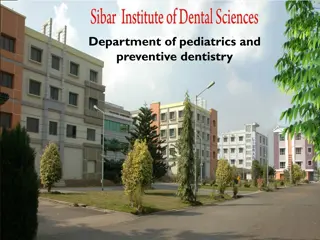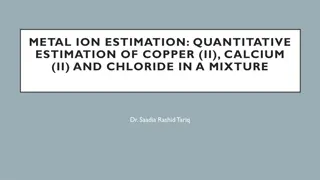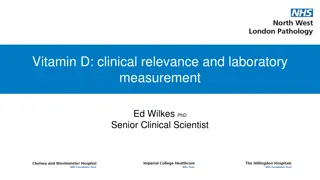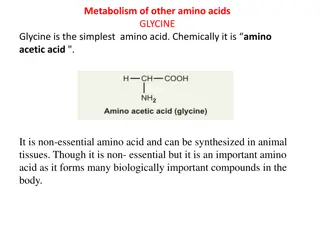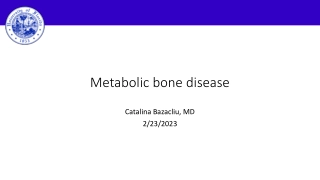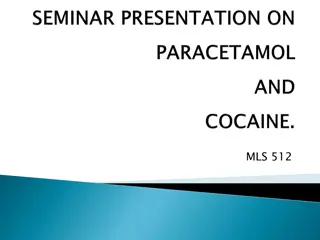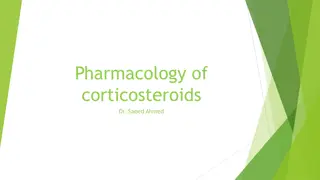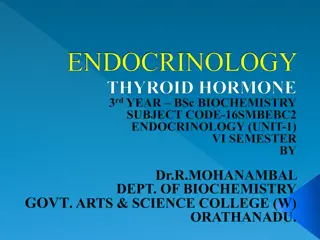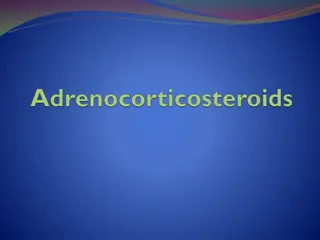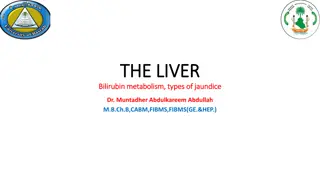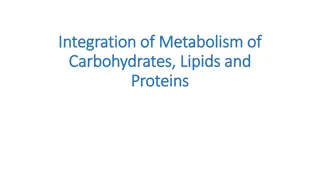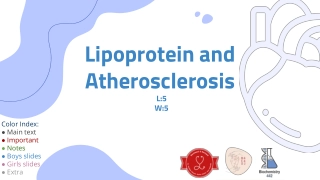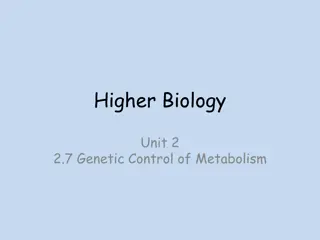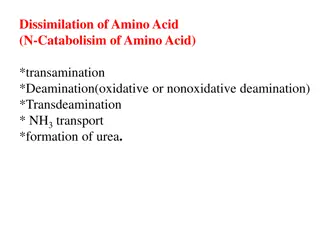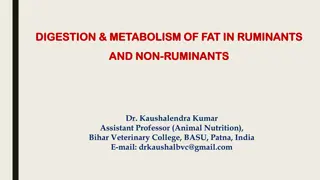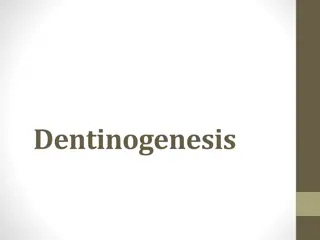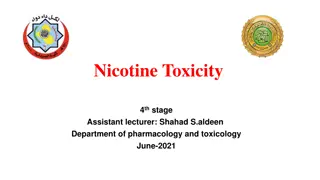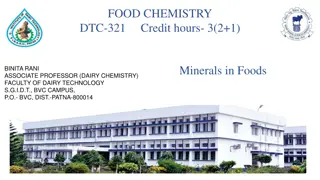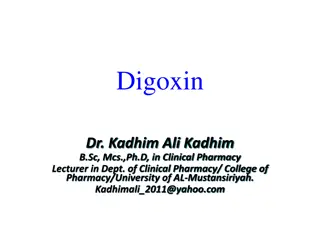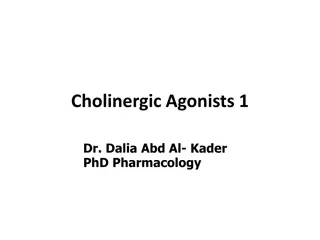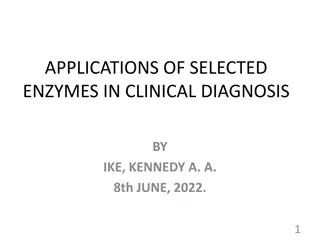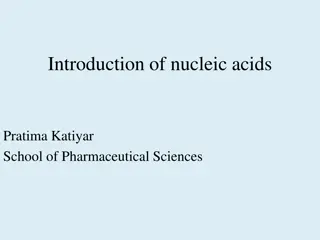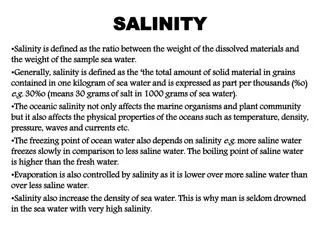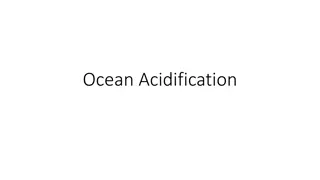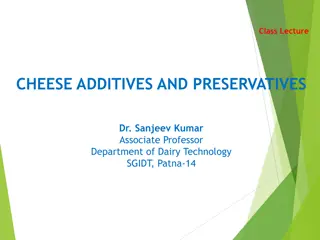Understanding Calcium Metabolism: A Comprehensive Overview
Calcium metabolism plays a critical role in various bodily functions like nerve conduction, coagulation, and bone mineralization. It involves processes such as calcium absorption, distribution, and homeostasis, regulated by hormones like PTH and calcitriol. The balance of calcium in the body is crucial for overall health, with factors like pH affecting ionized calcium levels. Reabsorption along the tubules and maintenance by osteoclasts and osteoblasts contribute to calcium homeostasis. This summary highlights the importance of calcium in cellular processes and bone health.
Download Presentation

Please find below an Image/Link to download the presentation.
The content on the website is provided AS IS for your information and personal use only. It may not be sold, licensed, or shared on other websites without obtaining consent from the author. Download presentation by click this link. If you encounter any issues during the download, it is possible that the publisher has removed the file from their server.
E N D
Presentation Transcript
Overview Calcium in cellular processes Calcium absorption Calcium distribution Calcium homeostasis Reabsorption by tubules Calcium regulating hormones CaSR Diuretics Novel proteins Ciclosporine and tacrolimus Hypertension Summary
Calcium in cellular processes An abundant cation in the body - approx 1000g in adults RDA 1000-1500mg/day
Critical role in Nerve conduction Coagulation Enzyme activation Exocytosis Bone mineralization Regulated by Intestinal absorption Renal absorption Bone turnover Hormones PTH, calcitriol, iCa2+
Intestinal calcium absorption Small intestine by both active and passive mechanisms Active duodenum and jejunum Passive entire length
Calcium and bone metabolism Major Ca2+ in the body Osteoclast and osteoblast maintain homeostasis
Calcium distribution Calcium in plasma is Filterable (60%) Bound (40%)
Filterable calcium is complexed with citrate , sulfate, phosphate (10%) Ionized calcium 50% % of calcium bound depends on pH Alkalemia - free calcium Acidemia - free calcium 1-g/dl change in albumin = o.8-mg/dl change in calcium 1-g/dl change in globulin = 0.16-mg/dL change in calcium
Regulation of calcium homeostasis by PTH-Vitamin D In states of neutral calcium balance , absorption = excretion
Reabsorption of calcium along the tubules Glomeulus filters 9000 10000 mg of complexed and iCa in 24 hours 250 mg excreted per day in urine Reabsorption PT & DT Only 1-2% of filtered calcium appears in urine
Proximal Tubule Passive reabsorption 70 % reabsorbed by paracellular processes linked with Na+ reabsorption Absorption not altered by PTH, cAMP, chlorthiazide, furosemide, acetazolamide Ca2+ permeates through claudin-2 and inhibits Na+ conductance Transcellular absorption undefined calcium channels and intra- cellular calcium proteins
Na+-K+-ATPase - In Na+ Ca2+ exchanger out Volume depletion PT Na+ absorption increases along with Ca2+ Saline administration decrease Na+ absorption and therefore Ca2+
In loop of Henle Thin ascending and descending limbs do not transport 20-25 % of Ca2+ reabsorbed by thick loop of henle (TALH) Para cellular route Claudin 16 & 19 Express furosemide sensitive NKCC2 Mediates re-absorption of Na+ and driving force for Ca2+ Through NKCC2 , a lumen-positive transepithelial potential is generated by 2 mechanisms 1. Apical recycling of K + via ROMK channel 2. NaCl diffusion potential generated by reabsorbed NaCl creating a concentration gradient Na-selective pathway This trans epithelial voltage driving force for passive Ca2+ reabsorption
Claudin 16 & 19 form a paracellular pore and regulates the tight junction Responsible for permeating Ca2+ ,Mg2+ Alternative hypothesis Claudins 16 & 19 form Na+ channels Form transepithelial NaCl diffusion potential divalent cation absorption Loss of function mutations in genes encoding Claudin 16,19 familial hypomagnesemia , hypercalciuria , nephrocalcinosis NKCC mutations Bartter s syndrome
In distal tubule Hormonally regulated Transcellular Active transport Mediated by channels , proteins and pumps In DCT & CT 5 to 10% of Ca2+ reabsorbed by active processes against electrical & concentration gradient Regulated by PTH, calcitonin , 1 ,25(OH)2D3 which increase efficiency of Ca2+ reabsorption Mediators - apically situated , transient receptor potential cation channel types 5 & 6(TRPV5,6) which increase Ca 2+ uptake from lumen into cell TRPV5 is the gatekeeper of Ca2+ re-absorption (mice)
Intracellular Ca2+ binding proteins calbindin D9K, D28K facilitate Ca2+ across the cell Plasma membrane calcium pump (PMCA) Na+Ca2+ exchanger (NaCX) NaCa2+K+ exchanger (NaCKX) increase rate of extrusion of Ca2+ across basolateral membrane
Regulation of Ca2+ transport Calcium regulating hormones Extra- cellular calcium Diuretics Estrogen Thyroid Magnesium Metabolic acidosis and alkalosis
Ca 2+ regulating hormones Alter expression of calcium channels , binding proteins, pumps & exchangers in kidney Most important - PTH 1 ,25(OH)2D3 (calcitriol)
PTH Released in response to low serum Ca2+ Via PTHrP, promotes reabsorption
Kidney Present in glomerular podocytes, PT, TALH,DT, CT 1. Increases activity of TRPV5 by activating cAMP-PKA signalling & phosphorylation - opening of the channel 2. Activates PKC pathway - number of TRPV5 on surface of tubular cells by inhibiting endocytosis Decreases excretion and increases re-absorption Intestine and bone Enterocytes increase Ca2+ reabsorption when stimulated with PTH PTHrP on osteoblasts and secrete RANKL Induces both bone formation and resorption , increasing total bone turn over
From renal proximal tubular cells Increases in response to low dietary Ca2+ and serum levels Physiological effect by interaction with Vitamin D receptor (VDR) Intestine Active Ca2+ transport Increases transcription of TRPV5, TRPV6, calbindins , NCX1,PMCA
Kidney Ca2+ reabsorption in DCT ?secondary to PTH increase Increases expression of TRPV5 and TRPV6 in DT, CT, CCD by increasing mRNA concentration Increase expression of calbindin D9K, D288K, PMCA pump Bones Regulation of bone metabolism and Ca2+ homeostasis VDR osteoblasts , osteoclasts , chondrocytes ?inhibit osteoblast differentiation and bone matrix mineralization Via RANKL activates osteoclasts Increases serum Ca2+
Calcitonin Thyroid C cells Ca2+ lowering hormone Used in malignant hypercalcemia, osteoporosis , Pagets disease
Estrogens Postmenopausal women have higher calcium excretion than premenopausal In early post-menopausal women , estrogen administration decreases urinary Ca2+ excretion , increases PTH and 1 ,25(OH)2D3 In mice lacking estrogen receptor alpha reduced duodenal TRPV5
Thyroid hormones Thyrotoxicosis hypercalcemia Correlates with bone demineralization and altered biochemical markers of bone turnover Hyperthyroid lower Ca2+ transport rates
Extra-cellular Calcium- CaSR Regulates renal Ca2+ reabsorption by signaling via Calcium Sensing Receptor on cell membrane (CaSR) Allows homeostasis even in minor changes in extracellular Ca2+ levels Present in PTH secreting parathyroid Calcitonin secreting thyroid Intestines Kidneys Determines how much Ca2+ moves in and out of the body via intestine and kidney How Ca2+ moves between bone and ECF
In proximal tubule Sub-apical region regulation of phosphate excretion Tight control of 1 ,25(OH)2D3 synthesis Luminal Ca2+ via CaSR modulate Na+ dependent proton secretion and water reabsorption Loop of Henle Basolateral side of TALH Modulates paracellular and transcellular NaCl and divalent cation transport CaSR activation induces Ca2+ loss
Activation of CaSR 1. renal tubular Ca2+ reabsorption 2. Induces calciuresis in response to Ca2+ load 3. Inhibits NKCC2 activity Ca2+ Regulates paracellular permeability CaSR antagonist - Ca2+ permeability , no Na flux Due to upregulation of Claudin-14 inhibits channels formed by claudin-16 & 19 Involves CaSR inhibiting calcineurin that activates nuclear factor of activated T calls (NFAT) which downregulates claudin 14 expression
In DCT Apical membrane and sub-apical vesicles Along with TRPV5 CaSR activation increase TRPV5 and therefore Ca2+ reabsorption In collection duct Urine Ca2+ levels influence acid excretion and water absorption in intercalated cells Prevent renal stones Hypercalciuria induces polyuria via CaSR in medullary CD Expressed in principal cells along with aquaporin 2 in apical membrane
Claudin-14 knockout mice Were unable to increase excretion of calcium in response to high Ca2+ diet Had complete loss of urinary Ca2+ excretion in response to CaSR agonist or antagonist
Diuretics Loop diuretics urinary calcium losses Due to its ability to bind to and inhibit furosemide-sensitive NKCC2 on TALH NaCl absorption , K+ recycling Reduces lumen positivity and therefore Ca2+ reabsorption Bartter s syndrome with mutation of NKCC2 calciuria Compensatory occur in DT channels and proteins such as TRPV5, TRPV6, Calbindin D28K with furosemide but does not compensate excretion
Thiazide diuretics Cause hypocalciuria Independent of PTH Bind to and inhibit Na-Cl cotransporter in DT Chronic use ECF reduction which enhances Na+ & Ca2+ reabsortion in PT DT Ca2+ transport unaffected Development of Hypocalciuria compensatory increase in Na+ reabsorption secondary to initial natriuresis Upregulation of Na+H+ exchanger which is responsible for PT reabsorption of Na+ & Ca2+
Gitelmans syndrome & inactivating mutations of thiazide sensitive Na-Cl transporter Hypocalciuria, hypomagnesemia , volume depletion
Magnesium Hypercalciuria Ca2+ uptake by TRPV5 is inhibited Mg2+ supplementation prevent renal stone formation
Metabolic acidosis & alkalosis Acidosis hypercalciuria , bone loss , osteoporosis Affect reabsorption in DT, expression & activity ofTRPV5
Regulation of Ca2+ transport by Novel proteins Klotho Sclerostin
Klotho Co-receptor for phosphaturic peptide -FGF 23 Kidney and parathyroid specific protein Influences epithelial Ca2+ transport by deglycosylating TRPV5 Traps the channel in plasma membrane and sustains its activity
Sclerostin Osteocyte derived glycoprotein Influences bone mass Sclerosteosis inactivating mutation of sclerostin gene Van Buchem s milder form - down streaming of sclerostin gene Dense bone and skeletal over growth constricts cranial nerve foramina, foramina magnum - premature death Sclerostin Alters synthesis of 1 ,25(OH)2D3 Influences Ca2+ reabsorption in kidney No change in PTH
Increases excretion of calcium as opposed to PTH and 1 ,25(OH)2D3 Reduced sclerostin expression enhances Ca2+ reabsorption directly or through changes in 1 ,25(OH)2D3 synthesis 1 ,25(OH)2D3 synthesis direct or via FGF-23
Ciclosporine & Tacrolimus Cause increase bone turn over and hypercalciuria Osteoporosis Tacrolimus Increases urinary Ca2+ excretion by downregulating mRNA and protein expression of TRPV5 and Calbindin Ciclosporine Reduce expression of VDR on DCT Vit D resistance Inability to retain Ca2+ inspite of high Vit D levels
Hypertension Hypercalciuria 20% increase of Ca2+ excretion at any given urine sodium levels Low PMCA1b level and increase Calbindin levels Upregulation of Ca2+ proteins when compared to normotensives ? Due to decreased tubular reabsorption of Ca2+ along DCT
